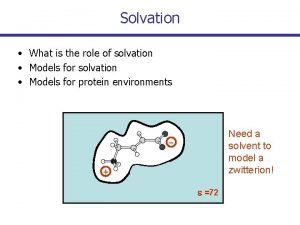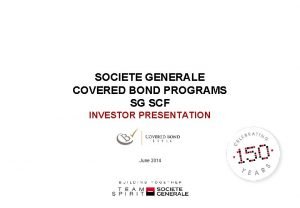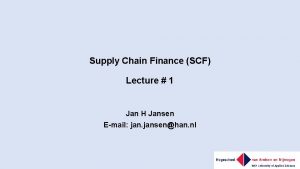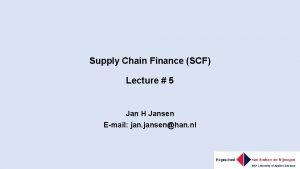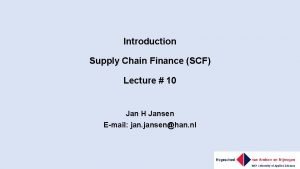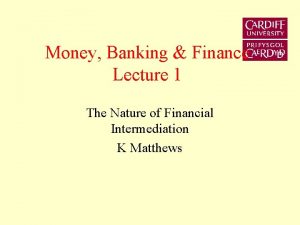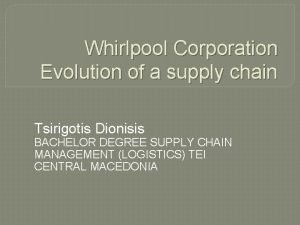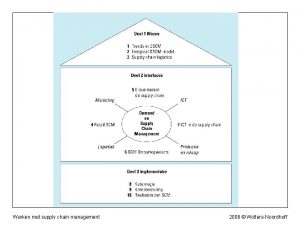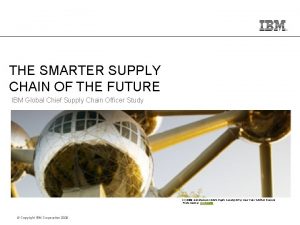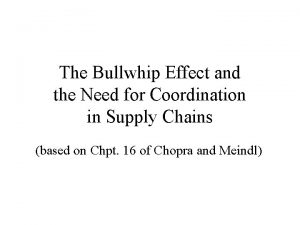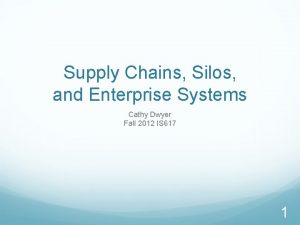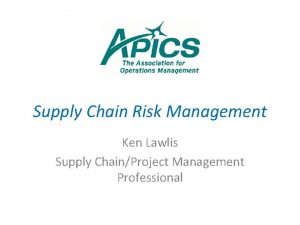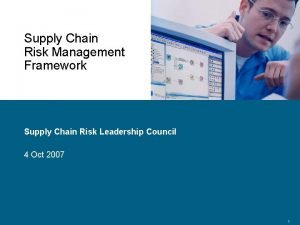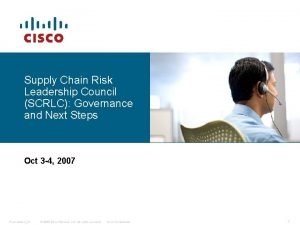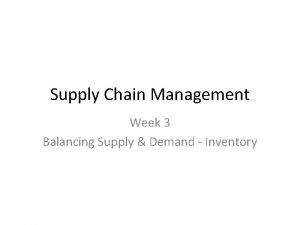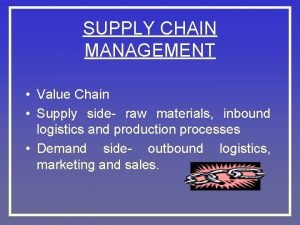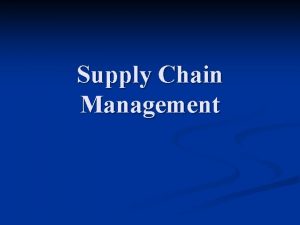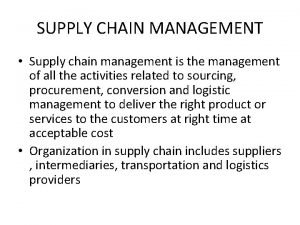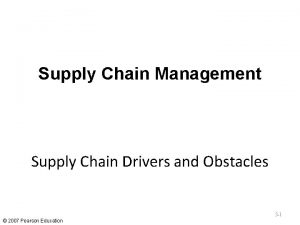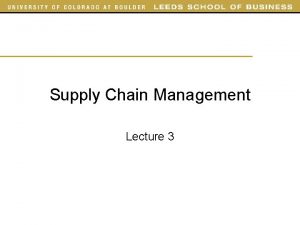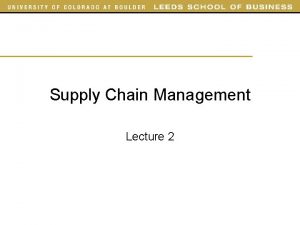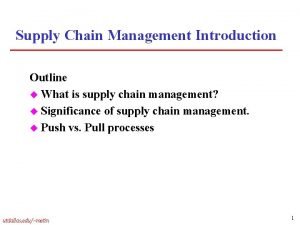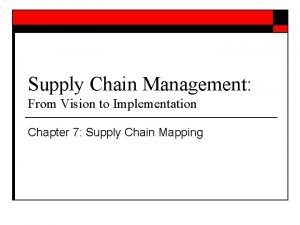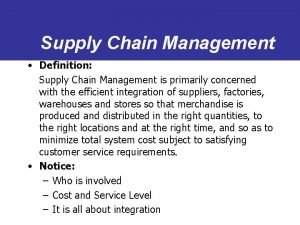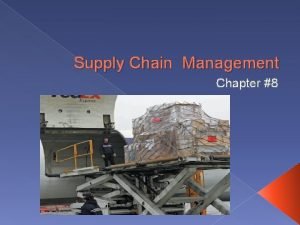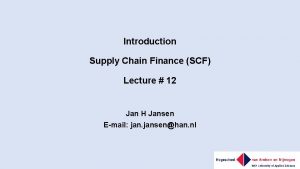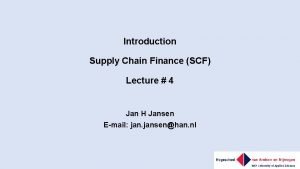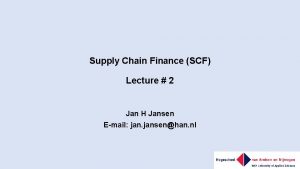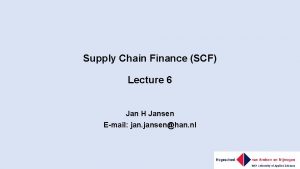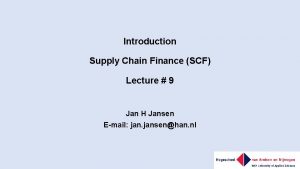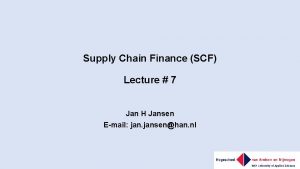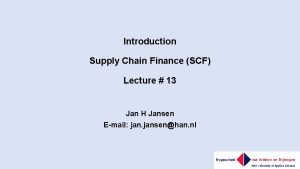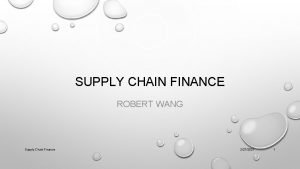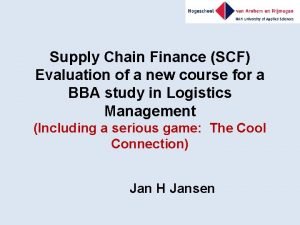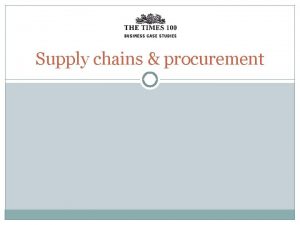Supply Chain Finance SCF Lecture 5 Jan H





































- Slides: 37

Supply Chain Finance (SCF) Lecture # 5 Jan H Jansen E-mail: jansen@han. nl

Lectures period 1 or 3 Lecture 1 Topic 2 Introduction SCF & Elements of SCF: SCM, Purchase, APS, ERP and ICT Financial ratios 3 Du. Pont Analysis & Value 4 Working Capital 5 Working Capital Management Dynamic Discounting 6 SCF instruments Introduction The Cool Connection Cool connection round 1 Risk management in SCF Cool connection round 1 (evaluation) 7 Preparation Assignment 1 Annual reports 2016 & 2017 Unilever, Philips & Heineken The Power of SCF Annual reports 2016 & 2017 Unilever, Philips & Heineken Assignment 2 Case study KPN Assignment 3 Case study SCF EU Assignment 4 Case study ACCA Standard definitions for Techniques of SCF EBA SCF Assignment 5 Standard definitions for Techniques of SCF EBA SCF

Recap Lecture 4

Continuation

Advantages SCF for SME’s An SME or start-up supplier that needs to wait a large number of days before receiving payment on an invoice effectively has the invoice sum unavailable to its financial operations until the invoice is settled. This has a negative effect on the working-capital ratio of the supplier (see above), and imposes financial risk on the supplier.

Added value of SCF for SME’s An important success factor for a Supply Chain Finance arrangement to work is to understand the position of suppliers and to gain their trust. As it is almost in all cases the buyer that together with a financial intermediary sets up the Supply Chain Finance arrangement, suppliers that are approached to participate in the arrangement fear to be taken for a ride. In the world of finance, and especially in buyer-supplier relationships, introduction of new financial arrangements do not usually lead to mutual benefit. The win-win aspect of Supply Chain Finance does not always appear immediately apparent to approached suppliers.


Any questions?

Supply Chain Finance: How it all fits together (developed by JH Jansen)

EVA™ Working Capital

Net Working Capital Note that NWC is not the same as Current assets & Current liabilities. Liabilities & Net Worth Assets Cash Accounts payable (A/P) Accounts receivable (A/R) Short-term debt Inventory Current assets Current liabilities NWC = ( A/R + Inventory ) - A/P

Operating and Cash Cycles Operating Cycle Accounts Payable Period Input Sourcing Period Quotation Period Price Quote t 0 Order Placed t 1 Accounts Receivable Period Inventory Period Inputs Received t 2 Order Shipped Payment Received t 3 t 4 time t 5 Cash Outflow Cash Intflow Cash Payment for Inputs Cash Settlement Received Cash Conversion Cycle

Conceptual model SCF for WCM in SMEs

SCF: Using the C 2 C variables to strengthen the supply chain (Source: Randall & Farris II, 2009, Int Journal of Physical Distribution $ Logistics Management) Sub-componnet supplier Instruments for Measuring and Testing of Electricity and Electrical Signals (SIC 3825) Tier 2 Supplier Component manufacturer Semi-conductors (SIC 3674) OEM Radio and Television Broadcasting and Communications Equipment (SIC 3663) Tier 1 Supplier Focal Company DPO (AP) 141. 0 days 49. 0 days 59. 3 days DSO (AR) 68. 6 days 29. 4 days 57. 1 days DIO 207. 9 days 83. 1 days 28. 3 days C 2 C 135. 5 days 63. 5 days 26. 1 days Explanation: DPOFC ≠ DSOTIER 1 and DPOTIER 1 ≠ DSOTIER 2

Example: Terms of Sale (EAR) On a € 100 sale, with terms 5/10 net 60, what is the implied interest rate on the credit given?

Assignment 4

Lecture 5 Working Capital & Dynamic Discounting

You place an order for 400 units of inventory at a unit price of £ 125. The supplier offers terms of 1/10, net 30. 1. How long do you have to pay before the account is overdue? If you take the full period, how much should you remit? 2. What is the discount being offered? How quickly must you pay to get the discount? If you do take the discount, how much should you remit? 3. If you don’t take the discount, how much interest are you paying implicitly? How many days’ credit are you receiving? 4. Calculate the EAR of the terms of sales of this offer from the supplier.

Solution 1. 2. How long do you have to pay before the account is overdue? If you take the full period, how much should you remit? 30 days & £ 50, 000 What is the discount being offered? How quickly must you pay to get the discount? If you do take the discount, how much should you remit? £ 500 & £ 49, 500 3. If you don’t take the discount, how much interest are you paying implicitly? How many days’ credit are you receiving? £ 500 & 20 days 4. Calculate the EAR of the terms of sales of this offer from the supplier. 20. 13%

EAR

Dynamic Discounting You. Tube: https: //www. youtube. com/watch? v=Iy. IIBh 4 ix. Eg To watch at home: https: //www. youtube. com/watch? v=84 zl. Uc. ULd 04

Source: http: //resources. taulia. com/h/i/10951527 -dynamic-discounting-for-dummies-infographic

Basic idea behind Dynamic Discounting Supplier offers terms of 2/10, net 30 • 2% discount within 10 days payment • Net payment within 30 days • Assume after 3 days you already confirmed the invoice • ERP system waits 10 days for the payment • Why not pay directly after 3 days? • Advantage for the supplier is clear • Advantage for the buyer? • Why should he do this? (and missing 7 days of credit from the supplier) • Higher discount? • Non-financial reasons?

Dynamic Discounting (Source: Standard definitions for techniques of supply chain finance, June 2015, Global supply chain forum) ‘A number of methods through which early payment discounts on invoices awaiting payment are offered to suppliers. The service is dynamic in the sense that the earlier the payment the higher the discount’

Days of early payment 30 29 28 27 26 25 24 23 22 21 20 19 18 17 16 15 14 13 12 11 10 9 8 7 6 5 4 3 2 1 0 Days of credit 0 1 2 3 4 5 6 7 8 9 10 11 12 13 14 15 16 17 18 19 20 21 22 23 24 25 26 27 28 29 30 Discount 3, 0% 2, 9% 2, 8% 2, 7% 2, 6% 2, 5% 2, 4% 2, 3% 2, 2% 2, 1% 2, 0% 1, 9% 1, 8% 1, 7% 1, 6% 1, 5% 1, 4% 1, 3% 1, 2% 1, 1% 1, 0% 0, 9% 0, 8% 0, 7% 0, 6% 0, 5% 0, 4% 0, 3% 0, 2% 0, 1% 0, 0%

Dynamic Discounting Discount 3. 5% 3. 0% Discount % 2. 5% 2. 0% Discount 1. 5% Linear(Discount) 1. 0% 0. 5% 0. 0% 0 1 2 3 4 5 6 7 8 9 10 11 12 13 14 15 16 17 18 19 20 21 22 23 24 25 26 27 28 29 30 Number of days crediit

Source: http: //primerevenue. com

Dynamic discounting (Source: http: //primerevenue. com

Case ACCA /

Source: http: //www. accaglobal. com/ab 111

Definition SCF ‘Supply chain finance can be defined (EBA 2013) as the use of financial instruments, practices and technologies for optimising the management of the working capital and liquidity tied up in supply chain processes for collaborating business partners. The development of advanced technologies to track and control events in the physical supply chain creates opportunities to automate the initiation of SCF interventions. ’

Checklist SCF 1. 2. 3. 4. 5. 6. 7. 8. 9. Fee structure (service costs & interest rates) Transfer of title Limits & Thresholds Payments Data (time based nature of SCF) Risk Benefits Costs Legal aspects

Supply Chain Finance Instruments (‘Umbrella’) Source: Standard definitions for techniques of Supply Chain finance, 2015

Reversed factoring (I) ‘The estimated global market size for reverse factoring ranges between US$255 billion and US$280 billion, of which about one-third can be attributed to Europe. An extrapolation for estimating the business potential of reverse factoring is to apply a 20– 25% ‘conversion factor’ to the value of accounts payables. ’

Reversed factoring (II) ‘Reverse factoring reduces costs across the supply chain by letting suppliers ‘borrow’ against their customers’ creditworthiness instead of their own. On average, 80% of the resulting value is shared between the suppliers and the buyer, with varying degrees of allocation depending on whether the buyer wants to facilitate its key suppliers’ financials (i. e. the largest share goes to supplier)or, instead, take all the benefits by extending payment terms. Typically, the buyer will capture 35% to 50% of all savings, while suppliers will get 25% to 45%. Another 15% goes to the financial intermediary while the remaining 5% is for the service provider. ’

Reversed factoring: Sharing benefits in the supply chain

Reversed factoring: Market size
 Scf ttm
Scf ttm Fsu.instructure
Fsu.instructure Socgen investor relations
Socgen investor relations Polyself.xyz paradigm
Polyself.xyz paradigm Dynamic discounting definition
Dynamic discounting definition Standard definitions for techniques of supply chain finance
Standard definitions for techniques of supply chain finance Matching supply with demand
Matching supply with demand What is logistics management
What is logistics management Food chain food chain food chain
Food chain food chain food chain 01:640:244 lecture notes - lecture 15: plat, idah, farad
01:640:244 lecture notes - lecture 15: plat, idah, farad Indirect finance
Indirect finance Switch mode power supply lecture notes
Switch mode power supply lecture notes Chapter 5 section 1 supply
Chapter 5 section 1 supply Ratio ng elastisidad
Ratio ng elastisidad Whirlpool corporation evolution of a supply chain
Whirlpool corporation evolution of a supply chain Werken met supply chain management
Werken met supply chain management Viewpoint for project collaboration
Viewpoint for project collaboration Erp in supply chain management ppt
Erp in supply chain management ppt Ibm supply chain strategy
Ibm supply chain strategy Pipeline in supply chain
Pipeline in supply chain Behavioral obstacles in supply chain
Behavioral obstacles in supply chain Supply chain silos
Supply chain silos Supply chain risk register
Supply chain risk register Supply chain risk management framework
Supply chain risk management framework Supply chain risk management framework
Supply chain risk management framework Cisco supply chain risk management
Cisco supply chain risk management Supply chain risk leadership council
Supply chain risk leadership council Maq corporation case study
Maq corporation case study Raw material in supply chain
Raw material in supply chain Sequence of supply
Sequence of supply Supply chain it framework
Supply chain it framework Framework for structuring drivers
Framework for structuring drivers Netflix supply chain
Netflix supply chain Collaborative supply chain
Collaborative supply chain Replenishment cycle in supply chain
Replenishment cycle in supply chain Supply chain management process mapping
Supply chain management process mapping Supply chain management explanation
Supply chain management explanation Order promising module of supply chain management
Order promising module of supply chain management
